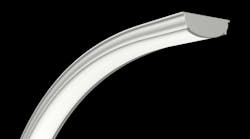Date Announced: 18 Nov 2009 Saint-Gobain has developed a new patented technology to manufacture arrays of gradient index planar lenses in glass at the wafer scale. Due to its unique properties, the resulting product is well suited for wafer-level packaging of LEDs. Technology description and main characteristicsIn those newly developed lenses, the optical function is not provided by the surface profile like standard spherical or aspherical lenses but by the gradual distribution of the refractive index inside the glass. As a consequence, the resulting optical element is perfectly flat. The bulk modification of the refractive index is achieved by ion exchange, namely by the substitution of ions initially present in glass with other ions which present a different polarisability. For the first time, Saint-Gobain has developed a special technology allowing the fabrication of arrays of such gradient index lenses at the glass wafer-scale. The patented process, based on silver diffusion assisted by an external electric field (also called electromigration process), is reliable, repeatable, efficient and allows the creation of optical elements with a broad range of 3D geometries (spheres, hemispheres, cylinders, ellipsoids…). Lateral sizes of the optical elements range from 200 μm to several cm whereas the vertical sizes (i.e. depth inside the glass) can reach up to a few mm. In particular, the optical elements can go through the entire glass thickness. Showed in the picture is an 8-inch glass wafer integrating 300 gradient index lenses. The glass thickness is 500 μm and the gradient index lenses have a pseudo hemisphere shape.At the current development stage, 1000 optical elements can be fabricated on an 8-inch wafer and in a near future; the goal is to reach 5000 lenses per 8-inch glass wafer. To succeed in controlling the process parameters as well as the final mechanical and optical quality of the wafers, special glasses have been formulated and synthesized. Among other properties, these patented special glasses present a large range of coefficients of thermal expansion from 40 to 100 10-7/°K. Main optical propertiesThanks to the unique diffusion process and the special glass compositions, the refractive index distribution can be finely tuned according to the targeted application. The amplitude of the refractive index variation can reach up to 0.12 (from an initial bulk glass optical index of 1.5) and various profiles of the gradient can be achieved. The full process can be simulated, allowing for quick and accurate determination of the optimum experimental parameters. This also allows modeling of customer’s downstream manufacturing steps (e.g.: reflow process, lens bonding…) so their potential impact can be anticipated and the initial lens design adjusted accordingly.Advantages• Planarity: the planarity of this gradient index patterned glass is of great interest for compact devices (e.g. mobile applications) where available space to incorporate optical functionalities is very limited. This feature also eases wafer handling during assembly process and allows additional functionalities through coatings (e.g.:anti-reflective). Besides, it opens the way to stack multiple optical elements at the wafer scale giving the opportunity to achieve very original optical designs which could not be realized through simple molding processes. • Aging resistance: as a mineral product, this optical glass is highly resistant towards UV-A, heat (up to 300°C for several hours without any change of the optical properties) and mechanical abrasion. This is a great advantage in comparison with plastic or hybrid materials. • Coefficient of thermal expansion: coefficient of thermal expansion of the glass can be adapted to the targeted application and to the material (silicon, ceramics…) on which it has to be bonded. Glasses with a CTE between 40 to 100 10-7/°K were developed in order to cover as many applications as possible. • Cost effective process: unlike existing lens array manufacturing technologies that typically involve complex and costly lithography and etching processes, the patented silver electromigration technology offers a cost effective solution for large volume manufacturing and Wafer-Level Packaging (WLP) of optical and optoelectronic devices. AcknowledgmentThe work was supported by OSEO-INNOVATION in the framework of MINIMAGE project.
Contact
Arnaud Huignard - Saint-Gobain Recherche Phone : +33 1 48 39 55 35 Fax : + 33 1 48 34 55 35
E-mail:[email protected]
Web Site:www.saint-gobain.com






